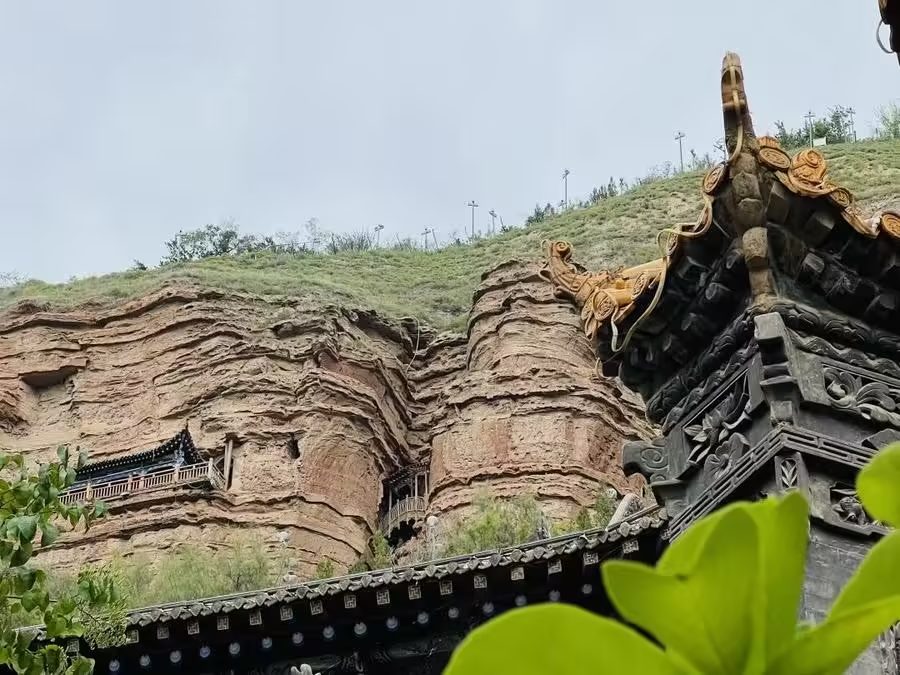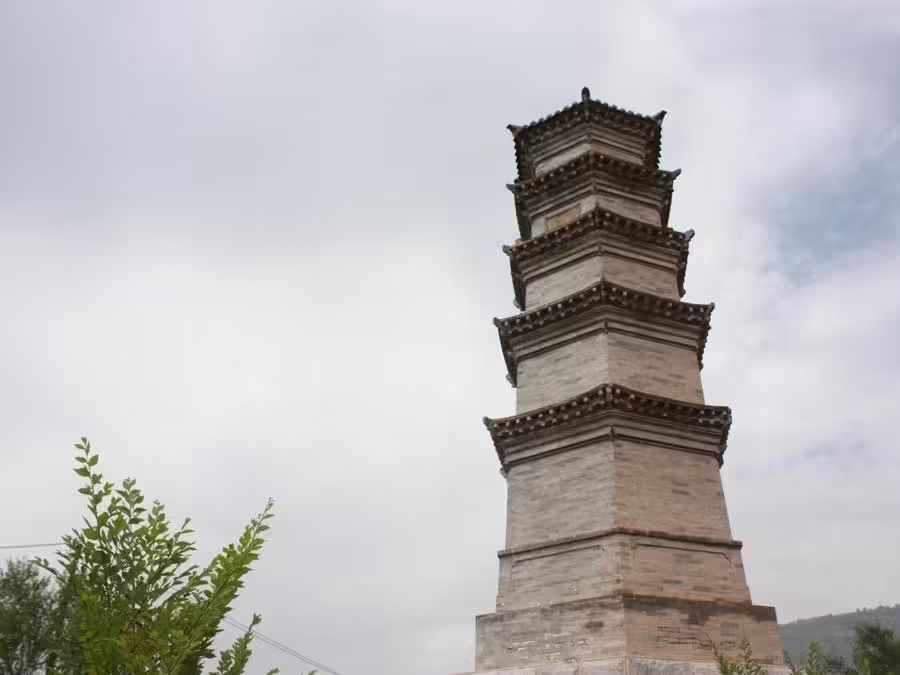Beichan Temple (北禅寺, North Zen Temple), also known as Tulouguan (土楼观) is situated on the northern slopes of Beishan Mountain, at an altitude of over 2,400 meters, alongside the banks of the Huangshui River in Xining, Qinghai Province. The temple is often referred to as “Beishan Temple” due to its location and striking architecture. Its name “Tu Lou Shan” (Earth Tower Mountain) comes from the unique geological formations of the mountain, which resemble terraced earth towers when viewed from a distance.
Originally established during the Northern Wei Dynasty in 506 AD, Beichan Temple is recognized as the earliest religious building in Qinghai, initially serving as a Buddhist temple. Over time, with the rise of Daoism in the region, it transitioned into a Daoist temple. The temple complex is ingeniously built into the natural red sandstone cliffs of Beishan, constructed sequentially from west to east along a natural fault line. This strategic design allows it to be backed by the mountain and perched above a deep valley, creating a breathtaking view.
The temple is known for its unique architectural style, featuring pavilions that seem to hang in mid-air, and the layout of the monastery is both intricate and orderly, making it a remarkable sight. Often referred to as “China’s second-largest hanging temple,” Beichan Temple attracts visitors not only for its spiritual significance but also for its stunning natural surroundings and architectural wonder.
Table of Contents
Basic Information
| Estimated Length of Tour | 1 – 2 hours |
| Ticket Price | Free |
| Opening Hours | 8.00 – 18.00 |
| Telephone Number | 0086-0971-5507110 |
Location and Transportation
Beichan Temple is located at 48 Qilian Road, in the northern district of Xining, Qinghai Province, China. It is situated on the hillside of Beishan Mountain, offering scenic views of the surrounding area. To get there, you can take bus 538 and get off at Beishan Tulouguan Stop (北山土楼观站).
Highlights of Beichan Temple
Lingguan Hall

As you arrive at the foot of the mountain, the first structure you will encounter is Lingguan Hall. Constructed during the Hongwu period of the Ming Dynasty, it was destroyed by fire and subsequently rebuilt in 1915. Originally, the hall featured a mountain gate, flanked by side rooms on both the east and west. In the center, there is a horizontal plaque bearing the words “Lingguan Hall.” The renovation of Lingguan Hall in the second year of the Xuantong era (1910) was funded by donations from various sectors of Xining. Inside the hall, the deity Wang Lingguan is enshrined, depicted with a red face, three eyes, and wielding a golden whip. Wang Lingguan is regarded as a protective deity and mountain god in Daoism, similar to the Buddhist protector Weituo.
Wangmu Hall

Behind Lingguan Hall lies Wangmu Hall, which serves as the main hall of the Tu Lou Mountain complex and the primary venue for religious activities. The hall suffered a fire in 2007 and was reconstructed in 2008. It is said that the main activities of the West Queen Mother (Xiwangmu) take place in Qinghai, and this location is considered a sacred site for her manifestations, hence the primary focus of worship is dedicated to her. Beichan Temple is recognized as one of the centers for Daoist activities in Qinghai Province, attracting numerous visitors from both domestic and international Chinese communities each year. The temple also hosts grand religious pilgrimage events from time to time. In recent years, during the evening of the Double Ninth Festival, Beichan Temple is adorned with colorful lights, drawing thousands of visitors for a lively celebration.
Outdoor Vajras

Above Wangmu Hall, a steep flight of stairs leads you to Tu Lou Mountain. In the middle of Tu Lou Mountain, there are two outdoor Vajras, one on the east and one on the west, connected to each other and standing over thirty meters tall. These outdoor Vajras originally formed from two protruding cliff edges, which have been sculpted by rain and wind over time, creating their unique geological shapes. During the Wei, Jin, and Northern and Southern Dynasties, devoted believers carved these natural formations into two large Buddha statues, known as the “Outdoor Vajras.” These statues are also referred to as celestial deities or heavenly kings, and are colloquially called “Shanfo” by the locals, meaning “Buddhas that flash out from the mountain.”
The western statue has been eroded and collapsed, making its features indistinct; however, the eastern statue remains intact. From a distance, the outlines of the Buddha’s head, torso, limbs, and facial features are clearly visible, exuding a robust and majestic presence characteristic of Tang Dynasty art, embodying a perfect blend of natural and cultural landscapes.
Ning Shou Tower

At the peak of Tu Lou Mountain stands Ning Shou Tower, a six-sided, five-story pagoda characterized by its upward-curving eaves and solid brick construction made of blue bricks. It is said to have been built during the nineteenth year of the Hongwu era of the Ming Dynasty (1386) by Geng Bingwen, a notable general and founding figure of the Ming Dynasty, although some sources suggest it may have been constructed during the Qing Dynasty. Legend has it that on misty, rainy days, the mountain shrouded in fog reveals the tower, palace, and caves intermittently, creating an ethereal atmosphere. From the summit, visitors can enjoy breathtaking views of the surrounding mountains and a panoramic perspective of the entire city of Xining.
Stone Carvings

Beichan Temple is constructed against the backdrop of Tu Lou Mountain’s unique Danxia landform, characterized by its red sandstone and gravel rocks, interspersed with layers of gypsum and mirabilite. The varying hardness of these rock types has led to the typical development of the Danxia landscape, featuring sheer cliffs, caves, and steep peaks as its primary characteristics. The softer rock layers have eroded inward, creating a series of caves of various sizes, commonly referred to by locals as the “Nine Caves and Eighteen Grottos.”
Inside these caves, statues of deities such as the Jade Emperor, Guanyin, Manjushri, Samantabhadra, and Guan Yu are carved. The cave walls are adorned with painted depictions of deities, floral patterns, and landscapes that exhibit influences from Han and Tibetan Buddhist artistic styles, representing relics from the Late Tang and Song-Yuan dynasties. This site is often hailed as the “Mogao Caves of Xining,” highlighting its cultural and historical significance.


